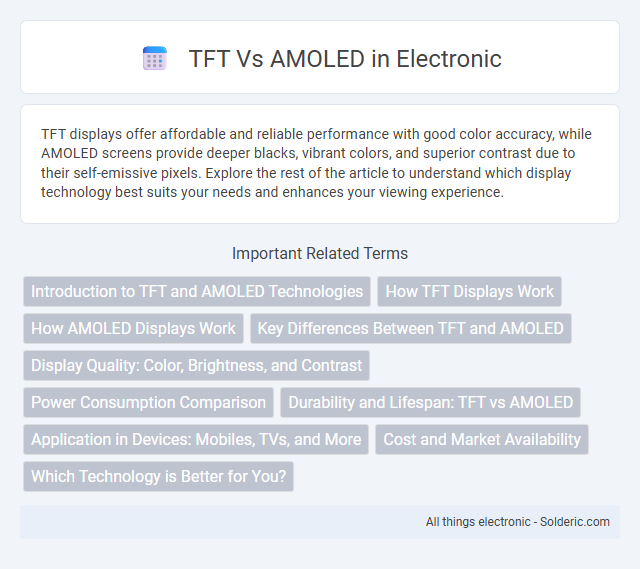TFT displays offer affordable and reliable performance with good color accuracy, while AMOLED screens provide deeper blacks, vibrant colors, and superior contrast due to their self-emissive pixels. Explore the rest of the article to understand which display technology best suits your needs and enhances your viewing experience.
Comparison Table
| Feature | TFT | AMOLED |
|---|---|---|
| Display Type | Thin Film Transistor LCD | Active Matrix Organic Light Emitting Diode |
| Brightness | Good brightness but lower than AMOLED | High brightness with better sunlight visibility |
| Color Accuracy | Less vivid, lower color contrast | Vivid colors with deep blacks and high contrast |
| Power Consumption | Higher power use due to backlighting | Lower power use, especially with dark themes |
| Viewing Angles | Narrower viewing angles | Wide viewing angles with minimal color shift |
| Flexibility | Rigid panels | Flexible, supports curved and foldable displays |
| Cost | Generally cheaper | More expensive due to advanced tech |
| Longevity | Long lifespan, less prone to burn-in | Prone to burn-in and shorter lifespan |
Introduction to TFT and AMOLED Technologies
TFT (Thin-Film Transistor) and AMOLED (Active Matrix Organic Light-Emitting Diode) are two advanced display technologies used in modern screens. TFT is a type of LCD technology that uses thin-film transistors to improve image quality and response times, commonly found in smartphones, monitors, and TVs. AMOLED combines OLED technology with active matrix addressing for faster refresh rates, deeper blacks, and higher contrast, enhancing Your viewing experience with vibrant colors and energy efficiency.
How TFT Displays Work
TFT (Thin-Film Transistor) displays work by using an active matrix of thin-film transistors to control each pixel individually, delivering precise image quality and faster response times compared to passive displays. Each transistor acts as a switch for the pixel's liquid crystal, enabling detailed color reproduction and sharp visuals essential for laptops, monitors, and smartphones. If you're comparing TFT to AMOLED displays, understanding that TFT relies on backlighting and liquid crystals while AMOLED uses self-emissive organic compounds will help you choose the best screen type for your needs.
How AMOLED Displays Work
AMOLED displays function by utilizing organic compounds that emit light when an electric current passes through them, eliminating the need for a separate backlight found in TFT LCDs. Each pixel in an AMOLED screen is independently controlled and emits its own light, which results in deeper blacks and higher contrast ratios compared to TFT displays. This self-emissive technology also enables thinner display panels and better energy efficiency, especially when displaying darker images.
Key Differences Between TFT and AMOLED
TFT (Thin Film Transistor) displays offer lower production costs and good brightness, but lack the deep blacks and vibrant colors found in AMOLED (Active Matrix Organic Light Emitting Diode) screens. AMOLED panels provide better contrast ratios, faster response times, and more energy efficiency due to each pixel emitting its own light without a backlight. Your choice between TFT and AMOLED impacts display quality, battery life, and viewing experience depending on your device usage.
Display Quality: Color, Brightness, and Contrast
AMOLED displays offer superior color accuracy, higher brightness levels, and deeper contrast due to their ability to light individual pixels independently, resulting in vibrant and true-to-life images. TFT screens often exhibit lower color saturation and brightness with less contrast, leading to a flatter and less immersive viewing experience. Your choice between TFT and AMOLED will significantly impact the vividness and clarity of visuals, especially in bright environments or when viewing high-contrast content.
Power Consumption Comparison
AMOLED displays consume less power than TFT screens because they individually light pixels, resulting in energy savings when displaying darker images or black backgrounds. TFT LCDs require a constant backlight, leading to higher overall power consumption regardless of screen content. In scenarios with predominantly dark interfaces, AMOLED technology can extend battery life significantly compared to TFT displays.
Durability and Lifespan: TFT vs AMOLED
TFT (Thin-Film Transistor) displays are generally more durable and less prone to burn-in compared to AMOLED (Active-Matrix Organic Light-Emitting Diode) screens, making them ideal for environments with heavy or prolonged use. AMOLED panels, while offering superior contrast and color vibrancy, tend to have a shorter lifespan due to organic materials that degrade over time, leading to potential color shifting and reduced brightness. Consequently, TFT technology often provides longer overall display longevity, whereas AMOLED requires more careful usage to maintain optimal performance.
Application in Devices: Mobiles, TVs, and More
AMOLED displays are widely used in premium smartphones due to their superior contrast, vibrant colors, and energy efficiency, enhancing your mobile viewing experience. TFT LCDs remain common in budget and mid-range devices and many larger screens like TVs, providing reliable performance and cost-effective production. In televisions, AMOLED technology is emerging but currently less prevalent than high-quality TFT LCD variants such as IPS and VA panels.
Cost and Market Availability
TFT displays are generally more cost-effective and widely available, making them a popular choice for budget-friendly devices and applications requiring large-scale production. AMOLED screens tend to be pricier due to their advanced technology and superior color accuracy, limiting their presence primarily to higher-end smartphones and premium gadgets. Your decision between TFT and AMOLED should consider the balance of upfront cost and market availability relative to your device needs.
Which Technology is Better for You?
TFT displays offer vibrant colors and lower production costs, making them ideal for budget-conscious users or devices requiring high brightness in direct sunlight. AMOLED screens provide superior contrast, deeper blacks, and better energy efficiency, perfect for those valuing display quality and battery life. Your choice depends on whether you prioritize affordability and brightness or enhanced color accuracy and power savings.
TFT vs AMOLED Infographic

 solderic.com
solderic.com